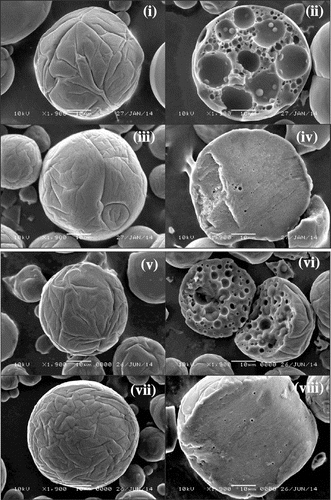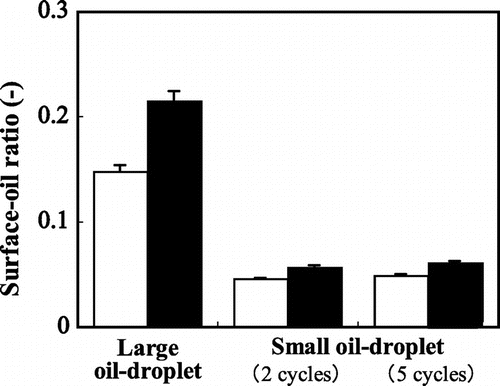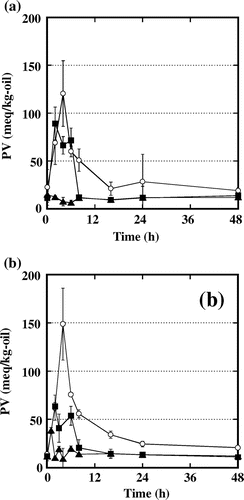Abstract
The effect of the size of oil droplets on the oxidative stability of flaxseed oil in spray-dried powders was investigated. Maltodextrin with a dextrose equivalent of 25 was used as a wall material, and sodium caseinate and transglutaminase-polymerized sodium caseinate were used as emulsifiers. The oxidative stability of flaxseed oil encapsulated in the spray-dried powders was evaluated using lipid oxidation and conductometric determination tests at 105 °C. The powders containing larger oil droplets exhibited higher surface oil content after spray drying, and higher peroxide value and conductivity after storage at 105 °C. Removal of the surface oil from the powders by washing with hexane significantly decreased the conductivity. The results indicated that the surface oil of the spray-dried flaxseed oil powders affected the oxidation stability.
Graphical abstract
Oil droplet size affected significantly the oxidation stability of flaxseed oil in spray-dried powder.
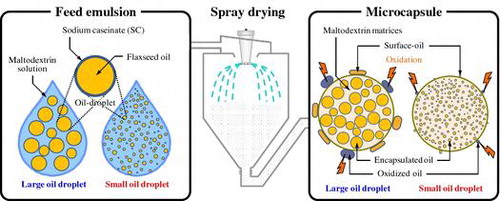
Flaxseed oil is regarded as a viable alternative to fish oil owing to its high α-linolenic acid content.Citation1) The n-3 polyunsaturated fatty acid (PUFA) family consists of α-linolenic acid and its longer-chain metabolites eicosapentaenoic acid (EPA) and docosahexaenoic acid (DHA). The health benefits of PUFAs, especially EPA and DHA, are well documented. For instance, PUFAs are effective in the prevention of cardiovascular diseases; exhibit anti-arrhythmic, anti-inflammatory, and hypotriglyceridemic effects; and are associated with lowered blood pressure and improved endothelial function.Citation2) Consequently, the demand for flaxseed oil in the food industry continues to rise. However, PUFAs are highly susceptible to oxidation and degradation.Citation3) Oxidation is generally initiated by air, high temperature, contact with transition metals, or exposure to ultraviolet light. Oxidative degradation of PUFAs results in loss of nutritional quality and spoiled flavor, thereby limiting the shelf life and affecting the sensory properties of the oil.
Microencapsulation with encapsulating agents such as maltodextrin, gum arabic, and milk protein, is an important technique used in the food industry to prolong the shelf life of oils.Citation4) The two-step microencapsulation process, i.e. emulsification of the core material and drying of the emulsion, transforms liquid oils into powdery solids. This process facilitates their handling and protects them from oxidation by means of a wall material that acts as a physical barrier, preventing diffusion of oxygen to the core material.Citation5) Of the various encapsulation techniques currently employed, spray drying is generally the most cost-effective, since the product can be obtained continuously in a one-step operation.Citation6) A key step in the spray drying technique is emulsion preparation, which has a significant influence on the surface oil content of the powder. Soottitantawat et al.Citation7) reported that emulsions with smaller oil droplets were more effective for the retention of orange oil. The most significant parameters to be considered in emulsion formation are the total solid concentration, oil content, viscosity, stability, oil droplet size, and emulsification method.Citation8,9) The surface oil of powder particles has been directly associated with the flowability and wetting properties of the bulk powders as well as their stability toward oxidation.Citation10) Ramakrishnan et al.Citation11) reported that the oxidation of microcapsules and the encapsulated oil depends on their surface oil content and the oxygen permeability of the microcapsule wall. Klinkesorn et al.Citation12) and Jafari et al.Citation13) reported a clear correlation between the oil droplet size in the parent emulsion and the extractable oil content in the spray-dried powder, and concluded that the amount of surface oil is affected by the diameter of the oil droplets.
Soottitantawat et al.Citation7) investigated the influence of emulsion and powder size on the stability of encapsulated d-limonene by spray drying and the emulsion size also affected to the stability of encapsulated flavor powder. They showed the small flavor size in the powder indicated the lower stability than the large size of flavor especially for the simple zero order kinetic oxidation of flavor (d-limonene). Lethuaut et al.Citation14) mentioned the decrease of oxidation rate of the small emulsion size should come from the decrease of the lipid molecules and increase of surface active compounds that could limit the initiation and propagation of the chain reaction. However, Ishido et al.Citation15) reported a lower oxidation rate of linoleic acid encapsulated in maltodextrin for the smaller size of feed emulsion. Accordingly, the effect of oil droplet sizes on the stability of oil is scarce and confusing. In this stage, there are no clear reports on the effect of oil droplet size on the stability of functional oil in spray-dried powder. Abd Ghani et al.Citation16) investigated the effect of oil droplet size on the stability of squalene oil in spray-dried powder and suggested smaller oil droplets in the powder had a smaller degradation rate constant. Flaxseed oil is a good model oil to investigate the stability of polyunsaturated acid in oil.
The purpose of this study is to investigate the effect of the oil droplet diameter on the oxidative stability of spray-dried flaxseed oil powder.
Materials and methods
Materials
Flaxseed oil was purchased from Wako Pure Chemical Industries (Osaka, Japan). Maltodextrin (MD, dextrose equivalent = 25, trade name ‘Pinedex #3’) was supplied by Matsutani Chemical Industry (Itami, Japan). Sodium caseinate (SC) was provided by Mitsubishi-Kagaku Foods Corporation (Tokyo, Japan). Transglutaminase (Activa®) was provided by Ajinomoto (Tokyo, Japan). Other reagents were of analytical grade. Distilled water was used in all experiments.
Crosslinking of sodium caseinate to form polymerized sodium caseinate
The crosslinking of SC was performed using transglutaminase. SC in distilled water (3 wt%) was mildly agitated in a shaking incubator (BR-15LF, Taitec Corporation, Saitama, Japan) at 30 °C with 100 nkat/g-SC transglutaminase for 20 h. This incubated solution was then heated to 90 °C for 10 min before being frozen in an acetone/dry ice bath, and dry polymerized SC (PSC) powder was obtained by lyophilization for 30 h in an FDU-1200 freeze dryer (Tokyo Rikakikai Co., Ltd., Tokyo). The crosslinking of SC was confirmed using sodium dodecyl sulfate -polyacrylamide gel electrophoresis (SDS-PAGE) (ATTO AE6530PCP, Tokyo, Japan) using mini precast polyacrylamide gels according to the method reported by Laemmli.Citation17)
Preparation of the feed emulsion
The carrier solution was prepared by dissolving MD as a wall material in distilled water at 60 °C, followed by cooling to room temperature. Flaxseed oil, as the core material, was introduced at 30 wt% with respect to the total weight of MD and SC. The oil was blended with the carrier solution to give a total oil and solid content of 37.9 wt%. The composition of the resulting feed emulsion was 11.4 wt% oil, 1.1 wt% SC, 25.4 wt% MD, and 62.1 wt% distilled water. The sample was homogenized using a rotor-stator homogenizer (PT-6100, Kinematica, Littau, Switzerland) operating at 8000 rpm for a total time of 3 min, with 30 s intervals between each minute of homogenization. The homogenized emulsion was further subjected to high-pressure homogenization to obtain a fine emulsion with smaller oil droplets. The emulsion was pushed from the chamber of a high-pressure homogenizer (Starburst Mini, Sugino Machine, Uozu, Japan) at 100 MPa through a small hole, twice at room temperature. The emulsion was then cooled to 15 °C in a water bath.
Spray drying of the emulsion
The feed emulsions were introduced into a pilot-plant spray dryer (L-8, Ohkawara Kakouki, Yokohama, Japan) equipped with a centrifugal atomizer. The detailed configuration of the spray dryer is described elsewhere.Citation18) The feed rate was 30 mL/min, the atomizer speed was 30,000 rpm, and the airflow rate was set at 110 kg/h. The inlet air temperature was 180 °C and the outlet air temperature was in the range of 80–90 °C. After cooling to room temperature, the powders were placed in closed glass containers and stored at −30 °C until use.
Scanning electron microscopy
The particle size and structure of the spray-dried powders were evaluated using a JSM-6060 scanning electron microscope (SEM, JEOL, Tokyo, Japan). The samples were deposited on a double-sided adhesive carbon tape placed on an SEM stub and subsequently coated with platinum-palladium using a Model MSP-1S magnetron sputter coater (Vacuum Device Inc., Tokyo, Japan). The SEM was operated at 10 kV with a spot size of 20 at 1900× magnification.
Analysis of oil droplet and powder-particle diameters
The size distributions of the oil droplets in the feed emulsion, the diameters of the oil droplets in the reconstituted emulsion, and the spray-dried powder particles were determined using a laser diffraction particle size analyzer (SALD-7100, Shimadzu Corporation, Kyoto, Japan) equipped with a batch sample cell by the method described by Soottitantawat et al.Citation7) To analyze the droplet size distribution in the feed emulsion, the emulsion was mixed with distilled water in the cell. To determine the size of the oil droplets in the reconstituted emulsion, the spray-dried powder was first dissolved in distilled water, and the suspended solution was then introduced into the cell. The particle size distribution of the spray-dried powder was analyzed by dispersing the powder in 2-methyl-1-propanol in the cell. The volume averaged diameter, D4,3, was used as the mean diameter in all measurements.
Moisture content measurement
The moisture content of each sample (1.5 g) was determined from analysis of weight loss using an infrared moisture analyzer (HB43, Mettler-Toledo International Inc., Greifensee, Switzerland) at a drying temperature of 160 °C until the weight remained stable for 50 s.
Total oil content
The total oil content in the spray-dried powders was determined by the dimethylformamide (DMF) method.Citation19) To completely dissolve the powder, DMF (1 mL) was added to the spray-dried powder (30 mg) in a glass bottle, after which hexane (1 mL) was added and the glass bottle was shaken with a vortex mixer. The sample was sonicated (Branson 1510, Yamato Scientific, Tokyo, Japan) for 15 min and then centrifuged for 10 min at 3000 rpm (2010, Kubota, Tokyo, Japan). A small aliquot (1 μL) of sample from the upper fraction, i.e. the hexane layer, of the mixture was spotted onto S-III chromarods (LSI Medience Corporation, Tokyo, Japan), developed with diethyl ether, and oven dried. Quantification of the oil contents on the rods was performed using an Iatroscan MK-5 thin-layer chromatography-flame ionization detector (TLC-FID) (LSI Medience Corporation). The hydrogen flow rate was 160 mL/min, the airflow was 1.6 L/min, and the scan time was 30 s.
Surface oil content
The spray-dried powders were washed with hexane by dispersing 0.3 g of the powder in 5 mL of hexane and vortexing for 15 min (Vortex Gene2, Scientific Ind., New York, USA). The post-wash hexane (1 μL) was spotted onto S-III chromarods. Quantification of the oil contents on the rods was performed using TLC-FID. The surface oil ratio was defined as the ratio of the amount of oil exposed on the surface of a microcapsule to the total oil content of the microcapsule.
Oxidative stability
The spray-dried powders (5 g) were placed in test tubes (ϕ 24 mm × 90 mm) held at 105 °C with a DTU-1B heat block (Taitec Corporation, Saitama, Japan). After incubation of the samples, the peroxide value (PV) was determined by the DMF method based on the AOCS Cd 8-53 acetic acid-chloroform procedure.Citation20) A sample (1 g) was dissolved in DMF (9 mL) under sonication, and combined with a chloroform–acetic acid mixture (3:2, v/v; 80 mL). A saturated solution of potassium iodide (1 mL) was then added. The mixture was hand shaken for 1 min and then kept in the dark for 5 min. After addition of distilled water (80 mL), the mixture was titrated against sodium thiosulfate (2 mmol/L) using a potentiometric titration system (East Ox Titrator, Mettler-Toledo International, Greifensee, Switzerland). A blank mixture was also analyzed under similar conditions. The PV (meq peroxide/kg-oil) was obtained using Equation (Equation1(1) ):
(1)
where C is the concentration of sodium thiosulfate (mol/L); VS and VB are the volumes of sodium thiosulfate exhausted by the sample and the blank, respectively (L); and M is the total oil content of the spray-dried powder (kg).
Conductometric determination tests
The generation of volatile degradation products from flaxseed oil in spray-dried powder was evaluated by the conductometric determination method (CDM),Citation21, 22) which employs accelerated oxidation conditions. The test method has been used to evaluate the oxidative stability of microcapsules in several previous studies.Citation23–25) The powder (0.2 g) was placed in a test tube (ϕ 24 mm × 90 mm) held at 105 °C in a DTU-1B heat block. The flow of air (100 mL/h) was continuously passed through the test tube using an air pump (SP208-1000 Dual II, GL Sciences, Tokyo, Japan), and bubbled into concatenated cold water. In this process, the volatile oxidation products were stripped from the sample and dissolved in the water, thereby increasing the conductivity of the water. The changes in the electrical conductivity were monitored with a conductivity meter (S230 SevenCompact conductivity, Mettler-Toledo International). The time taken to achieve a sharp increase in the conductivity was defined as the induction time, which is determined by the intersection of the baseline with the tangent of the conductivity curve.
Statistical analysis
All values from duplicate or triplicate determinations are expressed as the mean value ± standard deviation.
Results and discussion
Characterization of emulsion
The average diameter of the oil droplets of the emulsion prepared using the rotor-stator homogenizer and that of those prepared using the high-pressure homogenizer range from 3.7 to 4.1 μm and 0.10 to 0.28 μm, respectively. The profiles of the oil droplets prepared via rotor-stator homogenization were bimodal profiles, whereas monomodal profile was obtained with the use of high-pressure homogenization. In the case of high-pressure homogenization, the use of multiple passes leads to slightly smaller droplets compared to those obtained with a single treatment (Table ). These results clearly show that high-pressure homogenization produces oil droplets that are over 10 times smaller than those produced by rotor-stator homogenization alone.
Table 1. Variation of the average oil droplet diameter with the number of high-pressure homogenization cycles used for feed emulsions prepared using SC or PSC as an emulsifier.
The stabilities of the emulsions were evaluated by visual observation over 3 h of storage at room temperature. No creaming is observed in the emulsion prepared using the high-pressure homogenizer, indicating that the physical stability of the emulsion is significantly improved by high-pressure homogenization.
Emulsion of spray-dried powder
Six types of spray-dried powders with oil droplets of various combinations of sizes were prepared with SC. Figure shows the size distribution curve of the reconstituted oil droplets in the powders formed by high-pressure homogenization for 0, 2, and 5 cycles. The average diameter of the reconstituted oil droplets in the powders prepared with SC using the rotor-stator homogenizer or high-pressure homogenizer ranged from 3.5 to 4.2 μm and 0.12 to 0.25 μm, respectively. The size distributions of the reconstituted oil droplets were virtually equal to those of the oil droplets prior to spray drying. The average powder-particle diameters and moisture contents are similar for all the powders, and these values are summarized in Table . Based on their average diameters, the reconstituted oil droplets were classified as large oil droplets (>1 μm) and small oil droplets (<1 μm).
Fig. 1. Size distribution of oil droplets in reconstituted emulsions prepared with (a) SC and (b) PSC. Open symbols (○) represent the oil emulsion obtained by rotor-stator homogenization alone, and closed symbols (▲: 2 cycles, ■: 5 cycles) represent the emulsions obtained by high-pressure homogenization.

Table 2. Properties of spray-dried powders containing SC or PSC prepared by rotor-stator or high-pressure homogenization.
Powder morphology
Figure shows the microstructures of the spray-dried powders containing SC with large and small oil droplets. All the powder samples were solids (cross-section, Fig. ii, iv, vi, viii) and the particles were generally spherical with some wrinkles or scars on the surface (Fig. i, iii, v, vii). The powder particles prepared by rotor-stator homogenization clearly entrapped larger oil droplets than those prepared by high-pressure homogenization.
Surface oil ratio
The total oil content of the spray-dried powders was quantified using TLC-FID after hexane extraction, and the results agreed well with the initial oil content of about 30 wt% of the feed emulsion, regardless of the emulsion composition and homogenization conditions. Figure shows the surface oil ratios for the spray-dried powders. The surface oil ratios for the powders with small oil droplets (0.046–0.049) were significantly lower than those with large oil droplets (0.148). Thus, the oil droplet size has a remarkable effect on the surface oil ratio of the powders.
Lipid oxidation
The temporal variation of PV for the spray-dried powders with large and small oil droplets is shown in Fig. . At time zero, all samples were characterized by a low level of oxidation ranging from 11.5 to 22.6 meq/kg-oil. The powders with large oil droplets presented the highest PV at 4 h, reaching 120.6 meq/kg-oil. The PVs of the powders with small oil droplets obtained from 2 cycles of high-pressure homogenization remained almost constant at their initial values throughout incubation for 7 days. However, increasing the number of cycles to 5 significantly increased the PV. For these samples, the PV reached a maximum of 89.3 meq/kg-oil after 2 h. Kuhn et al.Citation26) reported that increasing the homogenization pressure increases the formation of primary oxidation products. Excessive emulsification processing may cause damage to the oil; therefore, powders treated with more high-pressure homogenization cycles are less stable to oxidation.
Effect on rancid odor
CDM evaluation of the flaxseed oil powders with large and small oil droplets (Fig. ) shows that the induction time of the powders with small oil droplets is shorter than that of the powders with large oil droplets. These results may be related to the total surface area of the oil droplets, which increases exponentially as the droplet diameter decreases.
Fig. 5. Induction time for spray-dried powders stored at 105 °C with airflow. Unfilled and filled bars represent the use of SC and PSC, respectively, as the emulsifier.
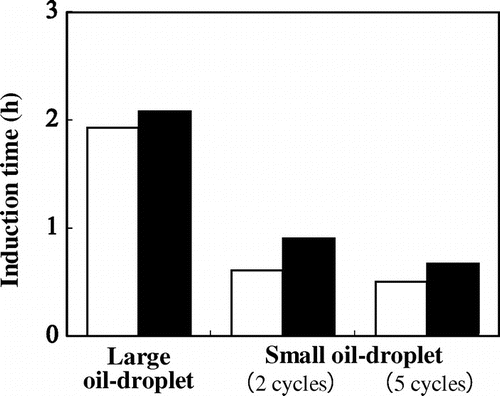
Lipid oxidation in microcapsules is regarded as an important factor influencing quality loss as it results in rancid odors. The hydroperoxides formed by oxidation of α-linolenic acid, which is the main PUFA in flaxseed oil, produce various volatile degradation compounds, including propanal, pentane, hexanal, 2-trans- and 3-cis-hexenals, heptadienal, octanal, and nonanal.Citation28) These components cause off-flavors and affect the odor of oils, even at extremely low concentrations of ~1 ppb.Citation30) Vinaixa et al.Citation31) reported that an increase in conductivity detected in the CDM evaluation is strongly correlated with the intensity of the rancid odors measured using metal oxide sensors and mass spectrometry. The changes in the conductivity observed during CDM evaluation of the spray-dried powders with large and small oil droplets are presented for comparison in Fig. . The conductivities after 1000 min of heating for the spray-dried powders containing large and small oil droplets were about 150 and 50 μS/cm. Thus, the spray-dried powders containing large oil droplets generate a larger quantity of volatile oxidation products. Conversely, the increase in the conductivity due to oxidation of flaxseed oil in the spray-dried powders was significantly suppressed by removal of the surface oil of the powder by hexane washing. These results suggest that the amount of surface oil on the spray-dried powders significantly affects the generation of volatile oxidation products from flaxseed oil powders.
Fig. 6. Evaluation of the air oxidation of flaxseed oil in microcapsules at 105 °C with airflow. Unfilled and filled bars represent the original powder and that washed in hexane.
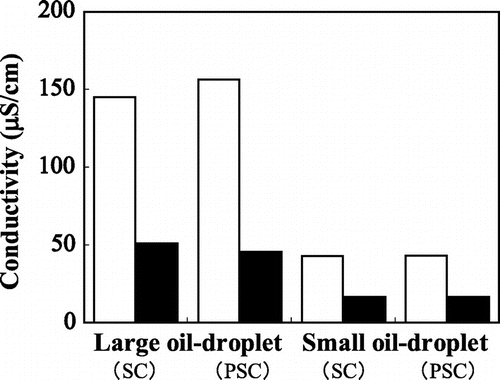
In this experiment, we could not get clear differences between oxidation data of SC and PSC. Transglutaminase treatment of SC did not affect the stability of flaxseed oil in our experimental condition. Bao et al.Citation27) demonstrated that the oxidative stability of microcapsules formed by spray drying of algae oil could be improved by cross-linking of the bovine casein layer using transglutaminase. Damerau et al.Citation28) reported that the amount of hexanal present in spray-dried sunflower oil powder decreased by about one third over the course of 29 weeks with the use of cross-linked SC with storage at 22 °C and a relative humidity of 54%. On the other hand, Kellerby et al.Citation29) showed that a cohesive cross-linked casein layer, formed by transglutaminase. On the interface of menhaden oil emulsions, did not influence the oxidative stability. There are no clear reports on the effect of transglutaminase on the stability of functional oil in spray-dried powder.
Conclusions
The effect of the size of oil droplets on the oxidative stability of flaxseed oil in spray-dried powder form was investigated in the formation of emulsified powders using MD as the wall material and SC as the emulsifier. The surface oil ratios of the powders with small oil droplets (0.046–0.049) were significantly lower than those with large oil droplets (0.148). Thus, the oil droplet size had a significant effect on the surface oil ratio of the powders. Oxidative stability tests showed that the powders containing larger oil droplets have a higher surface oil content, higher PV, and higher conductivity. Oil droplet size significantly affected the oxidation stability of flaxseed oil in spray-dried powder.
Author contributions
HY and HS conceived and designed the study. AN, SA, and ILP performed the experiments. HS and TLN analyzed the data. HS wrote the manuscript. HY and SA reviewed and edited the manuscript.
Funding
This study was performed as part of the joint research grant from the Mishima Kaiun Memorial Foundation.
Disclosure statement
No potential conflict of interest was reported by the authors.
References
- Bell JG, Henderson RJ, Tocher DR, et al. Replacement of dietary fish oil with increasing levels of linseed oil: Modification of flesh fatty acid compositions in Atlantic salmon (Salmo salar) using a fish oil finishing diet. Lipids. 2004;39:223–232.10.1007/s11745-004-1223-5
- McEwen B, Morel-Kopp MC, Tofler G, et al. Effect of omega-3 fish oil on cardiovascular risk in diabetes. Diabetes Edu. 2010;36:565–584.10.1177/0145721710372675
- Hamilton RJ, Kalu C, McNeill GP, et al. Effects of tocopherols, ascorbyl palmitate, and lecithin on autoxidation of fish oil. J Am Oil Chem Soc. 1998;75:813–822.10.1007/s11746-998-0231-4
- Jafari SM, Assadpoor E, He Y, et al. Encapsulation efficiency of food flavours and oils during spray drying. Drying Technol. 2008;26:816–835.10.1080/07373930802135972
- Soottitantawat A, Yoshii H, Furuta T, et al. Effect of water activity on the release characteristics and oxidative stability of D-Limonene encapsulated by spray drying. J Agric Food Chem. 2004;52:1269–1276.10.1021/jf035226a
- Gharsallaoui A, Roudaut G, Chambin O, et al. Applications of spray-drying in microencapsulation of food ingredients: An overview. Food Res Int. 2007;40:1107–1121.10.1016/j.foodres.2007.07.004
- Soottitantawat A, Yoshii H, Furuta T, et al. Microencapsulation by spray drying: influence of emulsion size on the retention of volatile compounds. J Food Sci. 2003;68:2256–2262.10.1111/jfds.2003.68.issue-7
- Jafari SM, He Y, Bhandari B. Role of powder particle size on the encapsulation efficiency of oils during spray drying. Drying Technol. 2007;25:1081–1089.10.1080/07373930701397343
- Huynh TV, Caffin N, Dykes GA, et al. Optimization of the microencapsulation of lemon myrtle oil using response surface methodology. Drying Technol. 2008;26:357–368.10.1080/07373930801898182
- Drusch S, Berg S. Extractable oil in microcapsules prepared by spray-drying: Localization, determination and impact on oxidative stability. Food Chem. 2008;109:17–24.10.1016/j.foodchem.2007.12.016
- Ramakrishnan S, Ferrando M, Aceña-Muñoz L, et al. Influence of emulsification technique and wall composition on physicochemical properties and oxidative stability of fish oil microcapsules produced by spray drying. Food Bioprocess Tech. 2014;7:1959–1972.
- Klinkesorn U, Sophanodora P, Chinachoti P, et al. Characterization of spray-dried tuna oil emulsified in two-layered interfacial membranes prepared using electrostatic layer-by-layer deposition. Food Res Int. 2006;39:449–457.10.1016/j.foodres.2005.09.008
- Jefari SM, Assadpoor E, Bhandari B, et al. Nano-particle encapsulation of fish oil by spray drying. Food Res Int. 2008;41:172–183.10.1016/j.foodres.2007.11.002
- Lethuaut L, Métro F, Genot C. Effect of droplet size on lipid oxidation rates of oil-in-water emulsions stabilized by protein. J Am Oil Chem Soc. 2002;79:425–430.10.1007/s11746-002-0500-z
- Ishido E, Hakamata K, Minemoto Y, et al. Oxidation process of linoleic acid encapsulated with a polysaccharide by spray-drying. Food Sci Tech Res. 2002;8:85–88.10.3136/fstr.8.85
- Abd Ghani A, Matsumura K, Yamauchi A, et al. Effects of oil-droplet diameter on the stability of squalene oil in spray-dried powder. Drying Technol. 2016;34:1726–1734.10.1080/07373937.2016.1190936
- Laemmli UK. Cleavage of structural proteins during the assembly of the head of bacteriophage 307 T4. Nature. 1979;227:680–685.
- Paramita V, Iida K, Yoshii H, et al. Effect of feed liquid temperature on the structural morphologies of D-limonene microencapsulated powder and its preservation. J Food Sci. 2010;75:E39–E45.10.1111/jfds.2010.75.issue-1
- Shiga H, Adachi S, Adachi S, et al. A simple method for determining the flaxseed or fish oil content with N, N-dimethylformamide in microcapsules prepared by spray drying. Jpn Soc Food Eng. 2014;15:131–139.
- AOCS official method Cd 8-53. Peroxide value acetic acid-chloroform method. In Official Methods and Recommended Practices of AOCS, 5th edition; Am. Oil Chem. Soc. Champaign, IL, 1999.
- Standard Method for the Analysis of Fats, Oils and Related Materials (Japan Oil Chem. Soc., ed.), 2013, Conductometric Determination Method, 2.5.1.2.
- Läubli MW, Bruttel PA. Determination of the oxidative stability of fats and oils: Comparison between the active oxygen method (AOCS Cd 12-57) and the rancimat method. J Am Oil Chem Soc. 1986;63:792–795.10.1007/BF02541966
- Velasco J, Dobarganes MC, Márquez-Ruiz G. Oxidation of free and encapsulated oil fractions in dried microencapsulated fish oils. Grasas y Aceites. 2000;51:439–446.
- Velasco J, Dobarganes C, Márquez-Ruiz G. Variables affecting lipid oxidation in dried microencapsulated oils. Grasas y Aceites. 2003;54:304–314.
- Velasco J, Dobarganes C, Holgado F, et al. A follow-up oxidation study in dried microencapsulated oils under the accelerated conditions of the Rancimat test. Food Res Int. 2009;42:56–62.10.1016/j.foodres.2008.08.012
- Kuhn KR, Cunha RL. Flaxseed oil—whey protein isolate emulsions: Effect of high pressure homogenization. J Food Eng. 2012;111:449–457.10.1016/j.jfoodeng.2012.01.016
- Bao S-S, Hu X-C, Zhang K, et al. Characterization of spray-dried microalgal oil encapsulated in cross-linked sodium caseinate matrix induced by microbial transglutaminase. J Food Sci. 2011;76:E112–E118.10.1111/j.1750-3841.2010.01953.x
- Damerau A, Moisio T, Partanen R, et al. Interfacial protein engineering for spray-dried emulsions—part II: Oxidative stability. Food Chem. 2014;14(144):57–64.10.1016/j.foodchem.2013.04.006
- Kellerby SS, Gu YS, McClements DJ, et al. Lipid oxidation in a menhaden oil-in-water emulsion stabilized by sodium caseinate cross-linked with transglutaminase. J Agric Food Chem. 2006;56:10222–10227.10.1021/jf062143w
- Cometto-Muñiz JE, Abraham MH. Odor detection by humans of lineal aliphatic aldehydes and helional as gauged by dose-response functions. Chem Senses. 2010;35:289–299.10.1093/chemse/bjq018
- Vinaixa M, Vergara A, Duran C, et al. Fast detection of rancidity in potato crisps using e-noses based on mass spectrometry or gas sensors. Sens Actuat B Chem. 2005;106:67–75.10.1016/j.snb.2004.05.038

